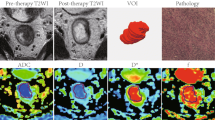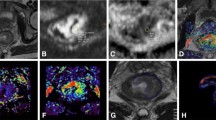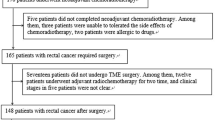Abstract
Purpose
The purpose of the study is to evaluate whether apparent diffusion coefficient (ADC) textures could identify patient with locally advanced rectal cancer (LARC) who would not respond to neoadjuvant chemoradiotherapy (NCRT).
Method
Twenty-six patients who underwent MRI including diffusion-weighted imaging at a 3.0 T system before NCRT were enrolled. Texture analysis of pre-therapy ADC mapping was carried out, and a total of 133 ADC textures as well as routine mean ADC value of the primary tumor were extracted for each patient. Texture parameters and mean ADC were compared between responsive group and non-responsive group. Logistic regression was used to determine the independent predictors for non-responders. Receiver operating characteristic curve (ROC) was performed to evaluate the predictive performance of the significant parameters.
Results
Eighteen of the 133 texture parameters significantly differed between responsive and non-responsive groups (p < 0.05). Further, energy variance and SdGa47 were identified as independent predictors for non-responders to NCRT; this logistic model achieved an area under the curve (AUC) of 0.908.
Conclusion
Texture analysis based on pre-therapy ADC mapping could potentially be helpful to identify patients with LARC who would not respond to NCRT.
Similar content being viewed by others
References
Fernandez-Martos C, Pericay C, Aparicio J et al (2010) Phase II, randomized study of concomitant chemoradiotherapy followed by surgery and adjuvant capecitabine plus oxaliplatin (CAPOX) compared with induction CAPOX followed by concomitant chemoradiotherapy and surgery in magnetic resonance imaging-defined, locally advanced rectal cancer: Grupo cancer de recto 3 study. J Clin Oncol 28(5):859–865
Gollins S, Sebag-Montefiore D (2016) Neoadjuvant treatment strategies for locally advanced rectal cancer. Clin Oncol (R Coll Radiol) 28(2):146–151
Jung SH, Heo SH, Kim JW et al (2012) Predicting response to neoadjuvant chemoradiation therapy in locally advanced rectal cancer: diffusion-weighted 3 Tesla MR imaging. J Magn Reson Imaging 35(1):110–116
Travaini LL, Zampino MG, Colandrea M et al (2016) PET/CT with fluorodeoxyglucose during neoadjuvant chemoradiotherapy in locally advanced rectal cancer. Ecancermedicalscience 10:629
Barbaro B, Vitale R, Valentini V et al (2012) Diffusion-weighted magnetic resonance imaging in monitoring rectal cancer response to neoadjuvant chemoradiotherapy. Int J Radiat Oncol Biol Phys 83(2):594–599
Ganeshan B, Skogen K, Pressney I, Coutroubis D, Miles K (2012) Tumour heterogeneity in oesophageal cancer assessed by CT texture analysis: preliminary evidence of an association with tumour metabolism, stage, and survival. Clin Radiol 67(2):157–164
Kim SJ, Pak K, Chang S (2016) Determination of regional lymph node status using (18)F-FDG PET/CT parameters in oesophageal cancer patients: comparison of SUV, volumetric parameters and intratumoral heterogeneity. Br J Radiol 89(1058):20150673
Hardiman KM, Ulintz PJ, Kuick RD et al (2016) Intra-tumor genetic heterogeneity in rectal cancer. Lab Investig 96(1):4–15
Fu F, Nowak MA, Bonhoeffer S (2015) Spatial heterogeneity in drug concentrations can facilitate the emergence of resistance to cancer therapy. PLoS Comput Biol 11(3):e1004142
De Cecco CN, Ganeshan B, Ciolina M et al (2015) Texture analysis as imaging biomarker of tumoral response to neoadjuvant chemoradiotherapy in rectal cancer patients studied with 3-T magnetic resonance. Investig Radiol 50(4):239–245
Grootjans W, Tixier F, van der Vos CS et al (2016) The impact of optimal respiratory gating and image noise on evaluation of intra-tumor heterogeneity in 18F-FDG positron emission tomography imaging of lung cancer. Journal of nuclear medicine: official publication, Society of Nuclear Medicine 57(11):1692–1698
Tixier F, Hatt M, Valla C et al (2014) Visual versus quantitative assessment of intratumor 18F-FDG PET uptake heterogeneity: prognostic value in non-small cell lung cancer. Journal of nuclear medicine: official publication, Society of Nuclear. Medicine 55(8):1235–1241
Funding
This study was funded by the Health Industry Special Scientific Research Project from the National Health and Family Planning Commission, China, No. 201402019.
Author information
Authors and Affiliations
Corresponding authors
Rights and permissions
About this article
Cite this article
Liu, M., Lv, H., Liu, LH. et al. Locally advanced rectal cancer: predicting non-responders to neoadjuvant chemoradiotherapy using apparent diffusion coefficient textures. Int J Colorectal Dis 32, 1009–1012 (2017). https://doi.org/10.1007/s00384-017-2835-3
Accepted:
Published:
Issue Date:
DOI: https://doi.org/10.1007/s00384-017-2835-3




